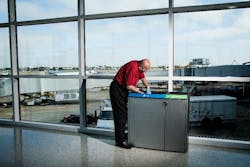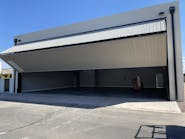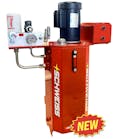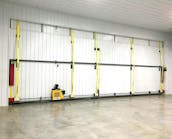While large commercial airports have traditionally outsourced services like janitorial maintenance and parking to contract service providers, smaller airports are also looking into it as well.
Courtney Wright, senior director of business development for Flagship Facility Services, said airports like Dallas Love Field (DAL) and Orlando Sanford International Airport (SFB) are seeing astronomical growth, which makes contracting services a lot more attractive.
“Unless it’s really small and you only have one or two janitorial people, it really does make sense to outsource this,” she said. “An airport’s business is to run an airport. They’re not experts on janitorial work, so it allows them to focus on their core business, which is running an airport.”
Wright said smart restroom technology along with automatic soap or paper dispensers are appealing to many airports.
“Everything comes back to passenger satisfaction,” she said. “A lot of these airports are focused. They’ve gotten their concessions where they want them to be, they got the Uber set up and now it’s really about enjoying the experience when they’re there and one of the biggest indicators of that are how clean is your airport, how efficient is your airport and how much time am I spending in line to get to the restroom.”
Airports should have a good scope of work when going to bid for contract work, Wright said, and what metrics they want to meet. They should then look at different technology and equipment are out there to meet those goals.
“Some of this technology, the airport is going to have to make a capital investment in their infrastructure,” she said. “Do they have that money available or is that something they would rather have the vendor do, so doing their research on what’s out there on the technology side or the equipment side and what kinds of questions they’re going to ask of the vendor in the RFP.”
Know When to Switch
Jonathan Wicks, a consultant with Walker Parking Consultants, said parking revenues can be an indicator it’s time to switch parking providers as well as expenses.
“If expenses have creeped up over time and you haven’t gone back to the market to try and see what is a competitive rate,” he said. “Not just from a salary and hourly wage standpoint, but all of the overhead and other costs that go into that.
Wicks said airports should look at the health and welfare rate being charged to the airport and see how it has increased with the cost of living index in the market. If the operator is charging an insurance rate to the airport for the garage keeper’s liability insurance or death and liability insurance and the rate has gone up, the cost could be reduced by putting an operation out to bid.
If IT or an off-site after hours call center isn’t being offered by the current operator, it might be something that another operator is willing to take on,” Wicks said. If innovation has stagnated, it could also be a sign it’s time to change.
He said another aspect to watch is how the operator is working with its contractors as well.
“Sometimes the operator and the local equipment and service provider, maybe they have too cozy of a relationship,” he said. “Sometimes it makes sense to review those contracts and providers separately, but do it in a way that says we really are getting the best deal that we can from each of these providers rather than having a provider be too comfortable and some other kind of deal between those two entities.”
One of the key indicators it’s time to look at outsourcing janitorial work is when an airport has trouble finding staff.
“They can’t recruit people, they can’t retain people, but that’s not their core responsibility, so they don’t know what they’re looking for in a janitorial worker or aircraft cabin cleaner,” Wright said. “When you have trouble filling positions, you’re short staffed and the scope isn’t getting done and you’re missing periodic work like window washings or floor cleanings because you can’t keep up with the daily work, that’s when it’s really time to start thinking about other options.”
Wright said companies like Flagship keep up-to-date with all the latest trends and equipment when it comes to facilities maintenance, so they can bring those new concepts into the airport realm.
“We have access to greater purchasing power because we do service not only in airports, but other accounts as well,” she said. “In terms of purchasing consumables or supplies, we’re buying that in bulk, so we get discounts, which can ultimately lead to cost savings.”
The Power of Change
Tulsa International Airport (TUL) changed its contracted parking operator to LAZ Parking in 2019 as part of its plans to upgrade operations. Fabio Spino, chief financial officer for the Tulsa Airports Improvement Trust, said the former parking operator ran the facilities for 25 years. During that time, the airport never did a significant investment in the software side of the parking management system.
“Currently, we’re running off of an antiquated revenue control system,” Spino said. “The software isn’t supported and the mechanicals are failing like our ticket dispensers and our gates, so what we need right off the bat is for them to work with us to put together a request for proposal for revenue control system.”
TUL goes out to bid every five years for parking services. Spino said there were about eight replies to the RFP. The airport did a tour of the facility so bidding companies could see the operations and outline the challenges TUL has as a growing airport.
“It was just one of those things that we know how to run an airport; we need guidance and expertise to help us tackle the current and future challenges that we’re going to face with parking,” he said. “It’s something that we definitely have to hire someone with an expertise and it made more sense to continue using a third party provider to help us learn what we didn’t know and having their expertise guide us through the process of running a more efficient customer service-oriented facility.”
TUL learned about LAZ and the company studied the Oklahoma market. Spino said they worked together to make a smooth transition to the new management. The company hired a number of staff from the previous operator, including the parking manger.
“It was just slight changes in procedures, learning and relearning,” he said
LAZ rebranded the garage and parking facility within the first month. Spino said he noticed a change in how they communicated with himself and other members of the team.
“It’s a more clear channel of communication that’s very responsive,” he said. “The parking manager has been given more support as far as the pool of knowledge they bring to the table and support mechanisms from not only their regional manager, but the manager above him.”
Wight said changing contract service providers can bring new ideas into an airport to improve efficiency. They can also bring in ideas used at other airports or industries to solve issues.
“Companies can get complacent when they’ve been in there for 20 years,” she said. “That happens a lot.”
The biggest concern in a vendor change is employees, Wright said.
“On average, we retain about 80 percent of the employees from the previous vendor,” Wight said. “But there’s always going to be attrition, but the priority is to work with the airport because there may people that they don’t want to keep or may want to let go, but were unable to let go due to unions or other things like that, so it’s during that transition period of doing all those interviews and making sure they’re a right cultural fit.”
Wright said they like to set up a transition oversight committee, where leaders can communicate all the data they need and give the vendor access to interview people.
Wright said Flagship will even do a mock go-live event prior to taking over services just to make sure everything runs smoothly when the change occurs..
Spino said it’s important to take a step back, look at the current provider, get an idea of challenges and needs when going to bid. TUL did a landside study, which put things into perspective on how busy the access road is, the current offering and the changing products available to travelers.
“Having that in your mind about what you want to provide and what your needs are, what kinds of services you’re expecting in the future, those are all things that anyone should take a moment and really discuss it with your leadership team,” Spino said. “Everybody has a certain point of view, so you get into a room with your leadership team and evaluate what our end goal is and it really lines things up for the organization.”
Wicks said to consider the scope of work you want to undertake when bidding for a parking operator. They can provide additional services and manage areas like ground transportation or TNC and taxi drop off points.
“We’re seeing airports using parking operators to manage their TNC pickup or drop off areas, whether it’s curbside at the terminal or in the parking garage or a remote lot,” he said. “Often times parking operators can provide that service to an airport as well.”
As the parking market gets more competitive, Wicks said airports are relying on parking operators to bring that innovation to the airport.
“The airport authority or whomever is managing the contract probably has a good sense of what other airports are doing, but the operators are out there on a daily basis trying to understand what the industry trends are and what might make sense,” he said. “They’re really there to be experts and to bring innovation to the airport as well and as a consultant, we’re trying to manage that relationship and that transfer of knowledge.”
Wicks said when trying to craft an RFP, they want airports to not just look at their immediate needs, but to bring on the right provider who can grow, change and innovate alongside the airport in the future.
“I can’t stress enough the amount of activity that’s needed to manage these systems properly has gotten more complex,” he said. “You want to make sure you’re bringing on a provider who can solve that need in a financially feasible and responsible sort of way.”
Spino said leaders can be very nervous about change, but, if you find the need to make a change, there’s probably a good reason for it.
“Change is scary, but embrace change,” Spino said. “With it comes new opportunities.”
Contract to Build a Positive Experience
Adenilto “Jr” Simoes, director of sales and marketing for Hallmark Aviation Services, said airports want to transform the lost-and-found services.
“In the past, at airports, it was an afterthought,” he said. “Now since airports are now rated through the ASQ on lost and found, they have shown a vested interest in really increasing their customer attraction and their return rates at different airports.”
Hallmark Aviation is the lost-and-found provider at Dallas Fort Worth International Airport (DFW) since 2018 and at Seattle-Tacoma International Airport (SEA) since April. The company also provides database software for lost-and-found services to Norman Y. Mineta San Jose International Airport (SJC).
“Returning a lost item has turned into a customer experience positive instead of a negative like in the past,” Simoes said.
Julie Collins, director of customer experience and brand strategy for the Port of Seattle, said they wanted customer service to be a very key priority of the lost and found service.
“One of the advantages we found with Hallmark is because they do have operations at Dallas Fort Worth already, they had people involved in that operation that were able to come and help start up our operations here,” she said. “They brought up a crew here that did training and went though a hiring process and they also wanted staff to better understand their company.”
Collins said the addition of the company filled a technology gap in the department as well. With the rapid growth of Sea-Tac, they’re opening a larger lost and found facility near the baggage claim area in the next year.
“There’s a lot of technology out in the lost and found arena that was advanced beyond the technology we were using,” she said.
The lost and found department has met the port’s goal of a 60 percent reunification rate, Collins said and Hallmark has been an attentive partner.
“They changed the way we were storing some of the lost and found items,” she said. “And certainly, the technology has been a major piece, so it has gone smoothly.”
Simoes said the contracted staff are trained on customer service and experience, so the focus remains on the customer and turning a negative situation into positive one.
The company provides phone trainings with staff on how to interact with customers on the phone so they can communicate effectively while avoiding issues like keeping someone on hold for an extended period of time..
Social media could be the clue if you need to look at contracting out this function.
“The customers have a larger voice in every business,” Simoes said. “The last thing you want as an airport is to have a negative interaction broadcast through every social media network or through the news.





